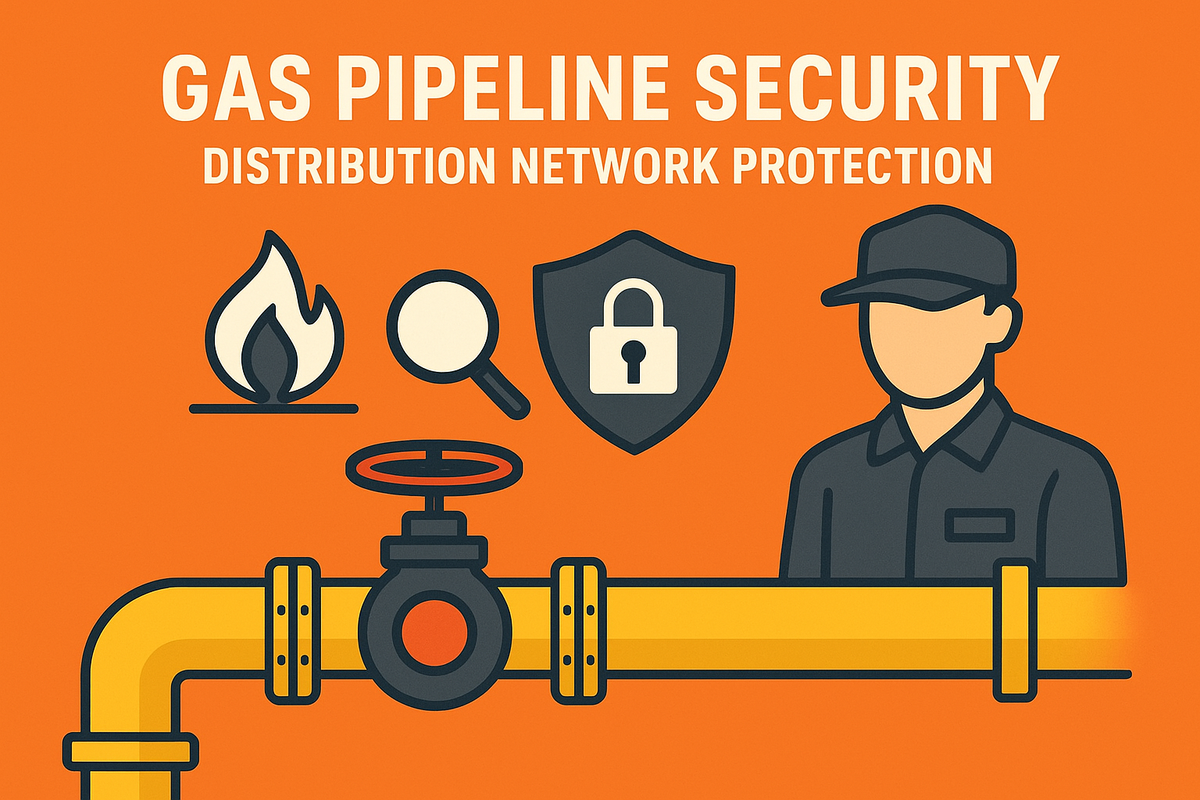Gas Pipeline Security: Distribution Network Protection

Introduction: Gas Pipelines—The Digital Backbone and Its New Risks
Gas pipelines form the backbone of national energy networks, distributing natural gas for power, industry, and domestic use. The digital transformation of distribution—through sensors, automated controls, and IT/OT integration—now exposes this critical infrastructure to sophisticated cyber and hybrid threats. Attacks can halt supply, destabilize economies, or threaten public safety in seconds.
Growing Threats in the 2025 Landscape
- Ransomware attacks have surged 935%, targeting US gas and oil assets at historic rates—disrupting billing, SCADA operations, and fuel flows while quadruple-extortion models threaten both operational shutdown and data leaks.
- Artificial intelligence now powers phishing, voice deepfakes, and malware customization, exploiting the weakest human link across control rooms and distributed sites.
- State-sponsored and criminal actors weaponize supply chain gaps—malicious firmware in sensors, infected third-party software, or cloned cloud credentials can open pipelines to remote hijack.
- Insider threats—through sabotage, careless device use, or weak credentials—remain a reality, with even trusted employees capable of cascading failures.
Critical Vulnerabilities and Attack Techniques
- SCADA and ICS platforms are often outdated or poorly segmented, vulnerable to direct ransomware or remote exploits.
- IoT and field sensors, including those riding on new private 5G and wireless links, form a vast “attack surface”—many devices with default settings or insufficient encryption.
- Weaknesses in cloud adoption (misconfigurations, missing MFA) allow data exfiltration or command injection across geographically dispersed networks.
- “Cut wire” sabotage—physical attacks on fiber links or sensors—can facilitate broader cyber campaigns, impacting reliability and situational awareness.
Incident Case Studies: Ransomware, Supply Chain, and Physical-Cyber Blends
- In 2025, Pakistan Petroleum Limited (PPL) rapidly contained IT ransomware, while earlier Suncor (Canada) and ExxonMobil (US) suffered major service and financial fallout from attacks crippling billing, downstream operations, and customer transactions.
- The Colonial Pipeline breach (2021) forced the largest pipeline in the US offline with IoT sensor lockouts, causing fuel shortages and panic buying; more than 45% of regional supply halted for days.
- Targeted “triton” malware at Saudi Aramco in 2017 was the first known direct attack on pipeline safety systems.
- Zscaler’s 2025 report: data exfiltration in ransomware events has doubled compared to previous years, with over 238 TB exposed or stolen.
Risk Factors: Market Conditions, Compliance, and Regulation
- As digitization increases, regulators escalate enforcement: ISA/IEC 62443, NIST SP 800-82, NERC CIP, and new TSA recommendations are obligatory for pipeline operators.
- Compliance gaps—poor asset inventory, missing segmentation, untested IR plans—bring not only business risk but potential fines and revocation of operating licenses.
- Geopolitical disruptions increase pipeline targeting, with ongoing East-West cyber tensions spilling into energy supply chain conflict.
Best Practices for Gas Pipeline Protection
- Segment, Secure, and Monitor: Create robust network segmentation between IT, OT, and field assets. Deploy next-gen firewalls, micro-segmentation, and continuous SCADA-aware monitoring.
- Zero Trust Framework: Enforce least-privilege access, multi-factor authentication everywhere, and real-time user behavior analytics.
- Resilient Incident Response: Regular tabletop and live IR exercises, isolated backups, and tested restoration paths minimize ransomware impact.
- Rigorous Supply Chain Oversight: Vet vendors for cyber hygiene, require secure-by-design components, and contractually enforce audit and update protocols.
- Invest in Workforce and Culture: Train control room and field staff against phishing and social engineering. Build reporting, vulnerability disclosure, and reward positive security behaviors.
- Physical and Cyber Convergence: Integrate cybersecurity with physical security; monitor, log, and automate response to cable cuts, unauthorized access, or device anomalies.
The Road Ahead: Future-Proofing Pipeline Security
- The rapid expansion of smart pipelines, AI, and IoT-driven field operations will only increase complexity and exposure—pipelines of the future must embed cyber resilience from design to daily operation.
- Threat sharing, sector-wide drills, and public–private coordination are essential to defend an increasingly interdependent, digital energy ecosystem.
Conclusion: Ensuring Safe, Reliable Gas Distribution
Protecting gas pipelines is now a 24/7, multidisciplinary challenge. Disruption risks have become existential and impact economic, safety, and environmental priorities. Meeting these challenges requires stronger technical controls, agile human response, strict compliance, and a culture of resilience at every level of energy operations.
Take the Next Step with CodeSecure Solutions
Cyber threats are growing more sophisticated every day. With a trusted partner by your side, you can safeguard your business while focusing on what truly matters—growth and innovation.
At CodeSecure Solutions, we deliver comprehensive cybersecurity services in Chennai, uniquely tailored for startups, SMEs, and enterprises:
- Vulnerability Assessment & Penetration Testing (VAPT)
- Network Security Solutions
- Compliance Support (ISO 27001, PCI-DSS, HIPAA, DPDP Act, GDPR)
- Cloud & Endpoint Protection
- Security Awareness Training
No matter your industry or size, CodeSecure customizes solutions to fit your needs—ensuring your data, reputation, and operations remain secure.
Ready to Strengthen Your Defenses?
- 📞 Call: +91 73584 63582
- ✉️ Email: [email protected]
- 🌐 Visit: www.codesecure.in
Stay secure. Stay informed. Choose CodeSecure Solutions—your partner in cyber resilience
